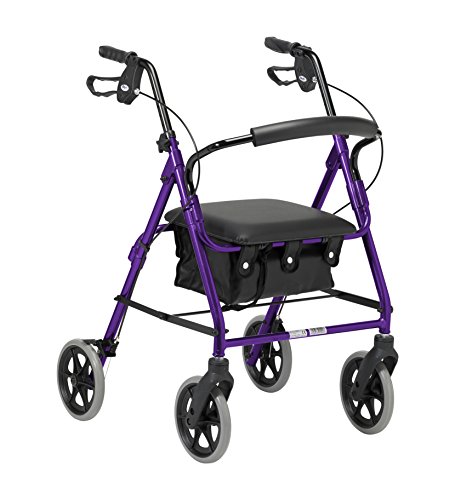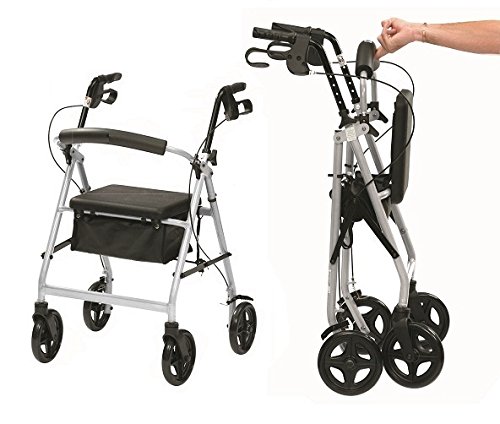You'll Never Be Able To Figure Out This Walking Aid Rollator's Benefit…
페이지 정보

본문
 The Benefits of Walking Aid Rollator [Https://Pediascape.Science/]
The Benefits of Walking Aid Rollator [Https://Pediascape.Science/]Rollators can help you reduce muscle fatigue and strain while also keeping you active. Selecting the right rollator for you and using it correctly and adding accessories and customization can enhance your walking experience.
Four-wheeled walkers give you better stability and support. They let you walk on different surfaces, whether outdoors or indoors. They also often come with a seating area and storage options to help you gain independence.
Stability
Rollators offer a solid base for walking, which is especially beneficial for people who have lost a portion of their balance due to injuries or the natural ageing process. Rollators distribute weight evenly, which eases pressure on knees, ankles and hips. In addition, the ability to be easily maneuvered through tight spaces - particularly by those who are unable to walk or struggle with gripping and controlling the handles of traditional walkers rollators makes them an ideal option for getting around busy shopping malls and other places that are crowded.
The durability of a rollator improves its ability to provide support on unnatural surfaces like uneven or sandy ground. This allows people to carry on their regular activities and stay active in their community. For people whose mobility is limited by chronic conditions or surgery or surgery, the use of rollators can be the difference between maintaining independence or becoming dependent on others for assistance with daily tasks.
The basic functions of a rolling device and walker are the same, however they differ in terms like stability and maneuverability, as well as whether or not you can sit down. When choosing the right mobility aid for you, it's crucial to test both in various settings to gauge which one is best 2 in 1 rollator transport chair suited to your personal needs and offers the most comfort. You should test them both indoors as well as outdoors on uneven and smooth surfaces, for long distances and in specific areas of your home, like the bathroom or narrow doorways.
While both types of walkers and rollators are designed to offer the feeling of mobility, the latter is more versatile as it can be folded to make transportation and storage simpler. Additionally, the majority of models have adjustable features that allow users to alter the height of their handles and the seat's depth, and the tension of their brakes for maximum comfort and safety. The frame of a walker that is rolling is usually made of lightweight rollators materials like aluminum, which makes it easier to maneuver and control. The wheels are made from lightweight materials that are durable and strong to ensure maximum performance.
Comfort
The Walker rollator is an excellent aid for people who are temporarily unable to walk. They can reduce the risk of falling and reduce the strain placed on the joints and muscles that are healing. This allows for a quicker and more comfortable healing while also allowing you to maintain an active lifestyle.
There are a variety of walkers with various features to meet the requirements of each user. They include different heights for the handlebars and brake options, as well as wheel sizes to accommodate each person's individual mobility needs. Some models also have a built-in seat that provides an enduring support on four wheels, so users can relax and sit whenever they need to. The seats that are padded are typically made to fold away and the unit can be easily transported when not in use.
The ergonomics of a walking aid rollator are also extremely important to ensure safety and comfort. The handles of a rollator are usually made from plastic, foam or other soft materials that are shaped to fit the wrists for maximum comfort when gripping. Many walkers come with extra accessories that increase comfort. These include bag hooks and umbrella/cane holders, drink holders and holders for smartphones.
Consult your physical or occupational therapy provider to determine the most appropriate option for your mobility needs. Walkers and rollators are great for those who require additional stability when walking, particularly older people who might be at a higher risk of falling. These simple aids to mobility can help prevent falls that could result in costly hospital bills and life-altering injuries.
Some walkers and rollators can be folded up for transport in cars and buses. If you can't fold your walker, however, you'll need to transport it, think about buying ski glides or rubber tips to make it easier to maneuver the walker. They can be bought online or from specialist suppliers like Essential Aids. They are a secure and durable solution that can be easily attached to a walker with clips made of plastic.
Mobility
A rollator may be the ideal aid to mobility for you or someone you love who is struggling with mobility issues. Rollators are often employed to help people recover from surgery or an injury or manage chronic conditions such as arthritis or multiples sclerosis, as well as age-related mobility issues. The aid provides stability and support, while allowing individuals to walk further distances and improve their posture.
As opposed to standard walkers that only have wheels on the front two legs, rollators come with wheels on all four legs to offer greater maneuverability. This allows them to go places that walkers with standard wheels might not be capable of as well as make sharp turns more easily. In addition, some of the rolling walkers have a seat to allow users to sit for balance and to rest when needed.
Rollators allow for greater mobility, allowing you to live your life and move around more freely. This can lead to a better quality of living. In addition research has demonstrated that walking rollator with a rollator lessens the stress on muscles and joints. This is due to the fact that walking with a rollator unloads the knee and ankle extensors, which allows other muscles to produce movement and alleviating strain on knee joints and hip joints as well as other joints in the leg and hips.
They are lightweight and compact which makes them easy for you to carry and store when not in use. Many models also have storage options like baskets, pouches, or trays to keep personal items and medical equipment within reach when you are on the move.
Essential Aids stocks a range of different wheeled walkers, with some models that have extra-thick, softly padded seats that are comfortable to sit on for longer periods. Some of these models have removable backs that allow you to sit on the rollator. Talk to an occupational therapist to learn more about the advantages of a walker that rolls or which one is right for you. They can offer expert advice and guidance about the most suitable mobility aid to meet your specific needs.
Safety
As a mobility aid it enhances mobility rollator walker and independence. It should be stable, with a seat and a solid grip. It should be durable, easy to maneuver and have dependable brake systems. The safest rollators will focus on these crucial elements to ensure user safety and satisfaction.
The frame is the backbone of the rollator. It must be lightweight to allow for easy maneuvering however, it must be sturdy enough that it can withstand the user's weight. Aluminum is the most popular material used for rollator frames, as it provides an extremely stable base that is easy to turn and push. Steel frames are also available for those who require more strength than aluminum models.
To prevent the rollator from rolling away from the user, it needs to include a hand brake lockable. This feature is typically found on the handlebars and can be used while walking to control the speed of the device. However, using a brake while moving with a rolling walker is not meant to replace the correct foot placement or a the proper posture.
A walker or rollator could be a great mobility aid for those who have imbalanced muscle function and balance problems. However, it is important to consult with a healthcare professional to determine which aid is suitable for your needs and limitations. A healthcare professional is in a position to offer specific advice, assist you in locating the best mobility aid to suit your lifestyle and will help you deal with any issues that may arise.
Walkers and rollators differ in numerous ways, from their frame to their handles and built-in seats. Walkers have four feet that are in contact with the ground while rollators have either three or four wheels. This distinction in function has an enormous impact on how easily the device can move and the amount pressure it places on the knees and hips.
The wheels of a rollator help distribute the user's weight more evenly. This eases the strain on the lower joints and decreases the risk of falling. Similar to the wheels on a walker are designed to aid in movement and aid users in navigating uneven terrain with ease.

- 이전글파워겔사용법, 레비트라 강간뉴스 24.12.19
- 다음글The Most Profound Problems In Buy A Category B Driving License Without An Exam 24.12.19
댓글목록
등록된 댓글이 없습니다.